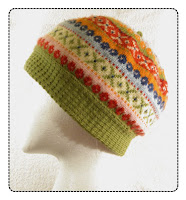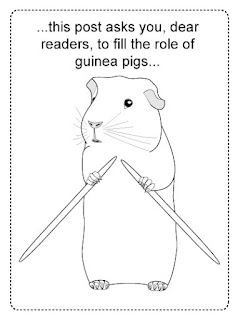This post is the third in a TECHknitting series. The others in the series are:
Part 1: How to knit with two or more colors: background information
This third post in the series covers how to knit with 2 colors on one hand, and
the (highly) related issue of how to knit with 3 colors. We'll also look at
various tricks to make 2 and 3 color knitting come out better.
As with everything else in knitting, there is more than one way to do a thing. This post is about knitting with two colors off the left hand--continental style and knitting three colors carrying two colors in the left hand, continental style, then adding a third color with the right hand knitting English-style. This is my method because I have never been able to work out how to carry more than one color on the English hand (right hand). If anyone is able to say how they knit two colors off the right hand at the same time, English style, oh please write: I'd love to hear about it.
TWO COLORS ON ONE (the left) HAND
There are two broad variations on carrying 2 colors of yarn on the left hand. One way is with gizmos, and the other way is by arrangement of the fingers. The gizmo category is dominated by two kinds of "strickfingerhut" (a Germanic word translated literally as: "knitting finger-hat", by which is meant "knitting thimble"). There is an excellent tutorial in how to use them
here. I can't shed further light, I don't use them. I do know here are testimonials on the web about how these gizmos have made color knitting possible for many, so if finger arrangement isn't working for you, check these gizmos out.
The second method is to carry two colors on the left hand by separating them somehow--I use my thumb as in the picture below, but there are other methods--I have seen a knitter carrying one yarn over her forefinger, and the other color over her middle finger.
click picture
By turning my thumb this way and that, I am able to "pluck" the correct yarn into the pick-up zone for the right (working) needle to grab.
click picture

Whether with strickfingerhutten or with finger arrangement, the idea is the same: to separate the yarns so the correct one can be plucked, while also keeping the yarns under tension. This means that tricks which work for one method can also work for the other.
TRICKS
A great first step towards easier two color knitting is to find a pattern which uses about the same amount of each of the two colors of yarn. In other words, you want to be able to feed both colors of yarn at the same rate. If you are attempting to feed yarn at different rates, you'll keep having to stop and re-tension and this is going to slow you down.
click picture
To explain: A pattern like "A" feeds yarn at two different rates: there are 2 stitches of blue color for each stitch of pink. Twice as much of the blue as of the pink must therefore pass through your left hand. The blue and the pink are held together in the hand--they are not separated until the very last part of the knitting process, when they pass on either side of a thumb, or through the loops of a strickfingerhut. This means that every stitch of blue is tugging along bit of pink and vice versa. But with twice as many blue stitches as pink ones, much more pink yarn is being tugged along than will be knit into the pattern.
In other words, knitting two yarns off one hand using a pattern with different feed rates has a tendency to bad tension. Correcting that tendency by pulling back on the pink yarn every few stitches overcomes the slackness problem, but that readjustment slows you down.
click picture
A pattern such as "B" feeds the two colors at the same rate: There are 2 stitches of blue for each 2 stitches of pink. It is true that after the second blue stitch, the pink yarn will have been tugged along twice, which slackens it. However, this extra pink yarn will be speedily knit up in its turn--it won't be building up ever-greater slack around the left needle tip, and causing tension trouble, or requiring continual readjustment, as in pattern "A."
click picture
As is evident, a pattern such as "C" is going to be harder to knit with proper tension than "B." It is true that pattern "C" feeds both yarns at the same rate BUT the pink has been tugged along 4 times by the time each blue repeat is completed (and vice versa). This is quite a bit of slack yarn to have built up, and the danger is that the first stitch of any color will be looser and slacker than the remaining three stitches, because there is more slack yarn hanging around during its formation than during the formation of the following three stitches. When you add to this danger, the the need to carry the yarn loosely in the float, it is obvious why carrying two colors on one hand goes faster and easier with a same-feed, short float pattern than otherwise.
click picture
Even if you do pick a pattern with a short repeat, short float and even feed rate like pattern "B," above, you're still not home safe. So far, we've only considered the horizontal arrangement of color knitting -- the easiest way to lay stitches down next to one another in the same round. However, successful fabric construction, requires addressing the vertical aspect of multi-colored fabric, too.
A pattern which carries the same colors along the same lines for a considerable distance up the fabric isn't easy to knit at a proper tension. This is because the floats rise to the surface of the fabric between the same 2 columns of stitches, as in the middle diagram, opposite. The yarn consistently rising to the surface from the back between the same two columns forces the fabric to break into a ribbing-like texture pattern, and this is true even if the floats are perfectly tensioned and the basic pattern follows all the rules for a good horizontal pattern, such as pattern "B" from above.
The solution is to have the floats surface between different columns in every round, or nearly every round (my own rule is not to knit more than 4 rounds with the same color-break). The best fabric is when a good basic horizontal pattern like pattern "B," above, is worked into a pattern like one of the four bottom diagrams--a pattern which is also going to work vertically--by staggering the color changes across different columns.
* * *
What a lot of limitations there are on knitting 2 colors off one hand--short floats, even feed rates, repeats staggered across columns of stitches! When you compare this sort of rule-bound knitting to
knitting one color off each hand, as shown in the previous post, you'll conclude (or at least, I'll conclude) that knitting one color off each hand is the more flexible method. With the two colors separated, different rates of feed are easy to accommodate--the yarn in the left hand does not tug along the yarn in the right hand because "never the twain shall meet." It is true that you still have to follow the rule of arranging to stagger your color breaks across different columns, but with different feed rates, the two colors of color knitting are less likely to wind up in the same columns to begin with. In other words, with "two-fisted" knitting comes the freedom to use vastly different feed rates, and far fewer restrictions in creating a viable, even-tensioned fabric.
So--with all these disadvantages, why would anyone want to learn to knit two colors off one hand? That is a good question! Now we are slowly coming to the heart of today's post. The answer is, knitting two colors off one hand turns out to be particularly useful when we come to three-color knitting.
THREE COLOR KNITTING
Although common wisdom says it's best to stick to two colors at any one time, the fact is that a surprisingly small amount of a third color--a highlight color--really perks up a two-color pattern.
click picture

IMHO, the very best and easiest sorts of 3-color patterns are those where the background color predominates, and the contrast and highlight colors appear in much smaller amounts. In this situation, the background color (main color) is laid down at an independent rate of feed with one hand (the right hand, English style). The contrast color and the highlight color are laid down with the other hand (left hand, continental style) at the same rate of feed as each other
(and THIS is where 2-colors-off-one-hand knitting comes into its own--in laying down the contrast and highlight colors). The photo above shows two such patterns, and shows how surprisingly effective a very small amount of a third, highlight, color can be in setting off what is essentially a two-color pattern.
To clarify further: in both of the patterns in the above illustration, there is a great deal more of the background color, and that is laid down, at its own independent rate of feed, by the right hand, knitting English style. The two contrast colors--the usual contrast color, as well as the third "highlight" color, are laid down with the two-colors-on-one hand method, laid down at the same rate of feed as each other, and knitted off the left hand. The zing added by a third color in even

moderate amounts make worthwhile the whole ordeal of learning to knit two colors off one hand.
BTW--The color patterns in the close-up illustration photo are adapted from a chart in a Dale of Norway booklet, #152, which has a pattern for a baby sweater using these colors and patterns worked in fingering weight yarn. If you are looking for a printed pattern to follow this would be a good one--I find color selections are intriguing, but if you don't, these could be changed--but the real point is that the construction of the color repeats make excellent mechanical sense.

The little sweater in the pattern book is steeked, but if steeking is not on your to-do list, or if a baby sweater is not, this color knitting pattern can be adapted to a hat.
--TECHknitter
You have been reading TECHknitting on: How to knit with 2 colors on one hand AND how to do three-color knitting (Part 3 of the how to knit colors series)








































